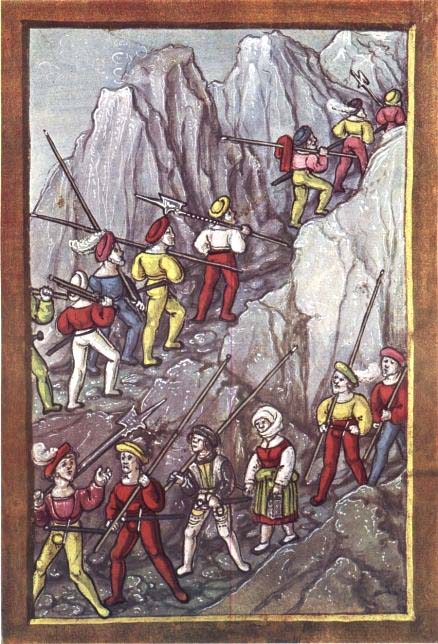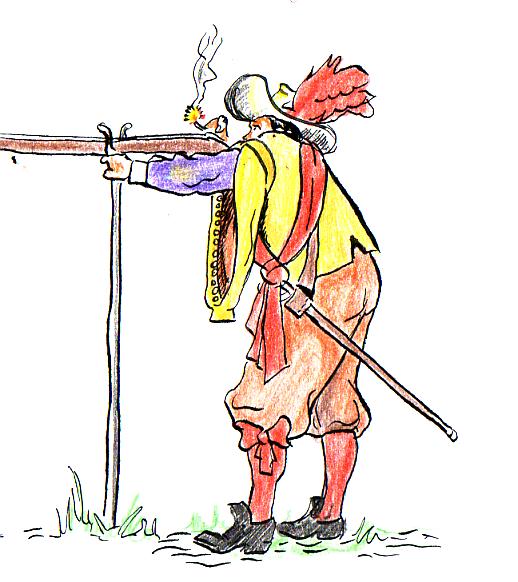|
Rodeleros
''Rodeleros'' ("shield bearers"), also called ''espadachines'' ("swordsmen") and colloquially known as "Sword and Buckler Men", were Habsburg Spain, Spanish troops in the early 16th (and again briefly in the 17th) century, equipped with steel shields known as ''Rondache, Rodela'' and swords (usually of the side-sword type). Originally conceived as an Italian attempt to revive the Roman legion, legionary swordsman, they were adopted by the Spanish and used with great efficiency in the Italian Wars during the 1510s and 1520s, but discontinued in the 1530s. The majority of Hernán Cortés' troops during his campaigns in the New World were rodeleros: in 1520, over 1000 of his 1300 men were so equipped, and in 1521 he had 700 rodeleros, but only 118 arquebusiers and crossbowmen. Bernal Díaz, the author of an account of Cortés' Spanish conquest of the Aztec Empire, conquest of the Aztecs, served as a rodelero under Cortés. When the Spanish adopted the ''colunella'' (the first of the ... [...More Info...] [...Related Items...] OR: [Wikipedia] [Google] [Baidu] |
Push Of Pike
The push of pike was a particular feature of Late Middle Ages and Early Modern warfare that occurred when two opposing columns of pikemen (often Swiss Reisläufer or German Landsknechte) met and became locked in position along a front of interleaved pikes. Shoving match During push of pike, opposing blocks of pikemen would advance with their pikes "charged" horizontally at shoulder level to jab at one another until bodily contact was made. The two sides would then push physically until one or other of them gave way. The push of pike would continue until one of the opposing formations routed or fled, which would generally lead to massive casualties. Each man pressed on the one in front, and so sometimes the formations would crush against each other and many pikemen would have to fight in closer melee combat. The rear ranks would sometimes join the fray but their primary role was to add more weight to the push. Aside from getting impaled by enemy pikes, those in the front ranks ... [...More Info...] [...Related Items...] OR: [Wikipedia] [Google] [Baidu] |
Rondache
The rondache or roundel was a shield carried by late Medieval and Renaissance foot soldiers (swordsman). It was made of boards of light wood, sinews or ropes, covered with leather, plates of metal, or stuck full of nails in concentric circles or other figures. Widespread among the infantrymen of northern Italy in the 15th century. See also * Ghisi Shield, another elaborate parade shield. *Rodeleros ''Rodeleros'' ("shield bearers"), also called ''espadachines'' ("swordsmen") and colloquially known as "Sword and Buckler Men", were Habsburg Spain, Spanish troops in the early 16th (and again briefly in the 17th) century, equipped with steel shi ... References Medieval shields {{medieval-armour-stub ... [...More Info...] [...Related Items...] OR: [Wikipedia] [Google] [Baidu] |
Tercio
A ''tercio'' (), Spanish for " third") was a military unit of the Spanish Army during the reign of the Catholic Monarchs of Spain and Habsburg Spain in the early modern period. They were the elite military units of the Spanish monarchy and essential pieces of the powerful land forces of the Spanish Empire, sometimes also fighting along with the navy. The Spanish ''tercios'' were one of the finest professional infantries in the world due to the effectiveness of their battlefield formations and were a crucial step in the formation of modern European armies, made up of professional volunteers, instead of levies raised for a campaign or hired mercenaries typically used by other European countries of the time. The internal administrative organization of the ''tercios'' and their battlefield formations and tactics grew out of the innovations of Gonzalo Fernández de Córdoba during the conquest of Granada and the Italian Wars in the 1490s and 1500s, being among the first to ef ... [...More Info...] [...Related Items...] OR: [Wikipedia] [Google] [Baidu] |
Swiss Mercenaries
The Swiss mercenaries were a powerful infantry force constituting professional soldiers originating from the cantons of the Old Swiss Confederacy. They were notable for their service in foreign armies, especially among the military forces of the kings of France, throughout the early modern period of European history, from the Late Middle Ages into the 19th century. Their service as mercenaries was at its peak during the Renaissance, when their proven battlefield capabilities made them sought-after mercenary troops. There followed a period of decline, as technological and organizational advances counteracted the Swiss' advantages. Switzerland's military isolationism largely put an end to organized mercenary activity; the principal remnant of the practice is the Pontifical Swiss Guard at the Vatican. Ascendancy During the Late Middle Ages, mercenary forces grew in importance in Europe, as veterans from the Hundred Years War (1337–1453) and other conflicts came to see soldi ... [...More Info...] [...Related Items...] OR: [Wikipedia] [Google] [Baidu] |
Swashbuckler
A swashbuckler is a genre of European adventure literature that focuses on a heroic protagonist stock character who is skilled in swordsmanship, acrobatics, and guile, and possesses chivalrous ideals. A "swashbuckler" protagonist is heroic, daring, and idealistic: he rescues damsels in distress, protects the downtrodden, and uses duels to defend his honor or that of a lady or to avenge a comrade. Swashbucklers often engage in daring and romantic adventures with bravado or flamboyance. Swashbuckler heroes are typically gentleman adventurers who dress elegantly and flamboyantly in coats, waistcoats, tight breeches, large feathered hats, and high leather boots, and they are armed with the thin rapiers that were commonly used by aristocrats. Swashbucklers are not usually unrepentant brigands or pirates, although some may rise from such disreputable stations and achieve redemption. His opponent is typically characterized as a dastardly villain. While the hero may face down ... [...More Info...] [...Related Items...] OR: [Wikipedia] [Google] [Baidu] |
Pikemen
A pike is a long thrusting spear formerly used in European warfare from the Late Middle Ages and most of the early modern period, and wielded by foot soldiers deployed in pike square formation, until it was largely replaced by bayonet-equipped muskets. The pike was particularly well known as the primary weapon of Spanish tercios, Swiss mercenary, German Landsknecht units and French sans-culottes. A similar weapon, the sarissa, had been used in antiquity by Alexander the Great's Macedonian phalanx infantry. Design The pike was a long weapon, varying considerably in size, from long. Generally, a spear becomes a pike when it is too long to be wielded with one hand in combat. It was approximately in weight, with the 16th-century military writer Sir John Smythe recommending lighter rather than heavier pikes. It had a wooden shaft with an iron or steel spearhead affixed. The shaft near the head was often reinforced with metal strips called "cheeks" or langets. When the troo ... [...More Info...] [...Related Items...] OR: [Wikipedia] [Google] [Baidu] |
Landsknechts
The (singular: , ), also rendered as Landsknechts or Lansquenets, were German mercenaries used in pike and shot formations during the early modern period. Consisting predominantly of pikemen and supporting foot soldiers, their front line was formed by ''Doppelsöldner'' ("double-pay men") renowned for their use of ''Zweihänder'' and arquebus. They formed the bulk of the Holy Roman Empire, Holy Roman Empire's Imperial Army (Holy Roman Empire), Imperial Army from the late 15th century to the early 17th century, fighting in the French-Habsburg rivalry, Habsburg-Valois wars, the Habsburg-Ottoman wars, and the European wars of religion. Although prone to mutiny if unpaid and divided within their ranks between Catholics and Lutherans, the ''Landsknechte'' were well-armed and experienced warriors, recruitable in large numbers throughout Germany and Austria by the Holy Roman Emperor. This guaranteed both quantity and quality to the Imperial military for a century and a half. At their ... [...More Info...] [...Related Items...] OR: [Wikipedia] [Google] [Baidu] |
Musketeer
A musketeer ( ) was a type of soldier equipped with a musket. Musketeers were an important part of early modern warfare, particularly in Europe, as they normally comprised the majority of their infantry. The musketeer was a precursor to the rifleman. Muskets were replaced by breech loading rifles as the almost universal firearm for modern armies during the period 1850 to 1870. The traditional designation of "musketeer" for an infantry private survived in the Imperial German Army until World War I. Historical antecedents The hand cannon was invented in Song dynasty China in the 12th century and was in widespread use there in the 13th century. It spread westward across Asia during the 14th century. The hand cannon evolved into the arquebus that appeared in Europe and the Ottoman Empire during the 15th century. The term musket was originally used to describe a heavy arquebus capable of penetrating heavy armor. Although this heavy version of the musket fell out of use after the mid ... [...More Info...] [...Related Items...] OR: [Wikipedia] [Google] [Baidu] |
Thirty Years War
The Thirty Years' War, fought primarily in Central Europe between 1618 and 1648, was one of the most destructive conflicts in European history. An estimated 4.5 to 8 million soldiers and civilians died from battle, famine, or disease, while parts of Germany reported population declines of over 50%. Related conflicts include the Eighty Years' War, the War of the Mantuan Succession, the Franco-Spanish War, the Torstenson War, the Dutch-Portuguese War, and the Portuguese Restoration War. The war had its origins in the 16th-century Reformation, which led to religious conflict within the Holy Roman Empire. The 1555 Peace of Augsburg attempted to resolve this by dividing the Empire into Catholic and Lutheran states, but the settlement was destabilised by the subsequent expansion of Protestantism beyond these boundaries. Combined with differences over the limits of imperial authority, religion was thus an important factor in starting the war. However, its scope and extent wa ... [...More Info...] [...Related Items...] OR: [Wikipedia] [Google] [Baidu] |
Pike (weapon)
A pike is a long thrusting spear formerly used in European warfare from the Late Middle Ages and most of the early modern warfare, early modern period, and wielded by infantry, foot soldiers deployed in pike square formation, until it was largely replaced by bayonet-equipped muskets. The pike was particularly well known as the primary weapon of Spanish tercios, Swiss mercenary, German Landsknecht units and French sans-culottes. A similar weapon, the sarissa, had been used in classical antiquity, antiquity by Alexander the Great's Ancient Macedonians, Macedonian phalanx infantry. Design The pike was a long weapon, varying considerably in size, from long. Generally, a spear becomes a pike when it is too long to be wielded with one hand in combat. It was approximately in weight, with the 16th-century military writer John Smith (High Sheriff of Kent), Sir John Smythe recommending lighter rather than heavier pikes. It had a wooden shaft with an iron or steel spearhead affixed. Th ... [...More Info...] [...Related Items...] OR: [Wikipedia] [Google] [Baidu] |






